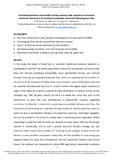JavaScript is disabled for your browser. Some features of this site may not work without it.
| dc.contributor.author | Wang, Kanming M. | |
| dc.contributor.author | Jefferson, Bruce | |
| dc.contributor.author | Soares, Ana | |
| dc.contributor.author | McAdam, Ewan J. | |
| dc.date.accessioned | 2018-08-20T09:13:20Z | |
| dc.date.available | 2018-08-20T09:13:20Z | |
| dc.date.issued | 2018-07-23 | |
| dc.identifier.citation | Wang KM, Jefferson B, Soares A, McAdam EJ.,Sustaining membrane permeability during unsteady-state operation of anaerobic membrane bioreactors for municipal wastewater treatment following peak-flow. Journal of Membrane Science, Volume 564, Issue October, 2018, pp. 289-297 | en_UK |
| dc.identifier.issn | 0376-7388 | |
| dc.identifier.uri | http://dx.doi.org/10.1016/j.memsci.2018.07.032 | |
| dc.identifier.uri | http://dspace.lib.cranfield.ac.uk/handle/1826/13414 | |
| dc.description.abstract | In this study, the impact of peak flow on anaerobic membrane bioreactor operation is investigated to establish how system perturbation induced by diurnal peaks and storm water flows will influence membrane permeability. Good permeability recovery was attained through increasing gas sparging during peak flow, which was explained by the transition in critical flux of the suspension at higher shear rates. However, supra-critical fluxes could also be sustained, provided peak flow was for a short duration. We suggest longer durations of supra-critical operation could be sustained through introduction of reactive fouling control strategies (e.g. TMP set-point control). An initial flux below the critical flux, prior to the introduction of peak flow, was advantageous to permeability recovery, suggesting membrane ‘conditioning’ is important in governing recoverability following peak flow. The importance of conditioning was confirmed through analysis of multiple peak flow events in which the loss of permeability following each peak-flow event was increasingly negligible, and can be ascribed to the arrival of a steady-state in membrane surface deposition. Whilst responding to peak flow with increased gas sparging has been shown effective, the energy demand is considerable, and as such a pseudo dead-end filtration strategy was also evaluated, which required only 0.04 kWh m−3 of energy for gas sparging. Comparison of both filtration modes identified comparable fouling rates, and the feasibility of a low energy gas sparging method for peak flow management that has successfully enabled supra-critical fluxes to be achieved over long-periods in other MBR applications. Importantly, membrane area provides the highest contribution toward capital cost of AnMBR. The potential to turn-up flux in response to peak-flow has been identified in this study, which suggests membrane area can be specified based on average flow rather than peak flow, providing substantial reduction in the capital cost of AnMBR for municipal wastewater treatment. | en_UK |
| dc.language.iso | en | en_UK |
| dc.publisher | Elsevier | en_UK |
| dc.rights | Attribution-NonCommercial-NoDerivatives 4.0 International | * |
| dc.rights.uri | http://creativecommons.org/licenses/by-nc-nd/4.0/ | * |
| dc.subject | Unsteady-state | en_UK |
| dc.subject | Diurnal flow | en_UK |
| dc.subject | Capital cost | en_UK |
| dc.subject | Membrane design | en_UK |
| dc.title | Sustaining membrane permeability during unsteady-state operation of anaerobic membrane bioreactors for municipal wastewater treatment following peak-flow | en_UK |
| dc.type | Article | en_UK |
Files in this item
The following license files are associated with this item:
This item appears in the following Collection(s)
-
Staff publications (SWEE) [2803]

